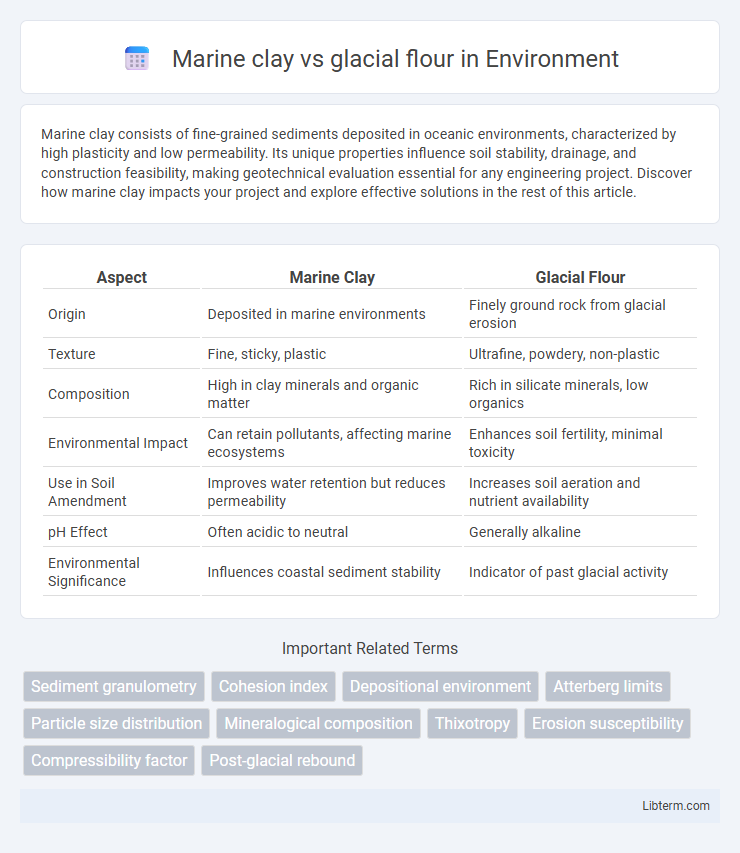Marine clay consists of fine-grained sediments deposited in oceanic environments, characterized by high plasticity and low permeability. Its unique properties influence soil stability, drainage, and construction feasibility, making geotechnical evaluation essential for any engineering project. Discover how marine clay impacts your project and explore effective solutions in the rest of this article.
Table of Comparison
| Aspect | Marine Clay | Glacial Flour |
|---|---|---|
| Origin | Deposited in marine environments | Finely ground rock from glacial erosion |
| Texture | Fine, sticky, plastic | Ultrafine, powdery, non-plastic |
| Composition | High in clay minerals and organic matter | Rich in silicate minerals, low organics |
| Environmental Impact | Can retain pollutants, affecting marine ecosystems | Enhances soil fertility, minimal toxicity |
| Use in Soil Amendment | Improves water retention but reduces permeability | Increases soil aeration and nutrient availability |
| pH Effect | Often acidic to neutral | Generally alkaline |
| Environmental Significance | Influences coastal sediment stability | Indicator of past glacial activity |
Introduction to Marine Clay and Glacial Flour
Marine clay consists of fine-grained sediment deposited in oceanic and coastal environments, rich in minerals like montmorillonite that affect soil behavior and stability. Glacial flour originates from the mechanical grinding of bedrock by glaciers, producing ultra-fine silt-sized particles that create nutrient-rich sediment when deposited in glacial meltwater lakes and rivers. Both materials influence soil composition and landform development but differ significantly in origin, particle size, and mineralogy.
Geological Formation Processes
Marine clay forms from the slow accumulation of fine sediments in oceanic or coastal environments, primarily derived from the weathering of continental rocks and biological debris settling on the sea floor over millennia. Glacial flour consists of extremely fine silt particles produced by the mechanical grinding of bedrock beneath glaciers during glacial movement, resulting in highly suspended sediment in glacial meltwater. The key geological difference lies in marine clay's chemical and organic sedimentation from water column deposition, whereas glacial flour is physically generated by glacial abrasion and transported via meltwater streams.
Physical and Chemical Properties
Marine clay exhibits high plasticity, fine grain size, and significant water retention due to its predominance of montmorillonite minerals, resulting in low permeability and high compressibility. Glacial flour consists mainly of finely ground rock particles like quartz and feldspar, characterized by low plasticity, coarse grain size, and minimal water absorption, leading to higher permeability. Chemically, marine clay contains elevated levels of organic matter and cations such as sodium and calcium, while glacial flour is primarily composed of inert silicate minerals with limited reactive surfaces.
Particle Size and Texture Differences
Marine clay typically exhibits fine particle sizes ranging from 0.002 to 0.05 mm, resulting in a smooth, cohesive texture with high plasticity and water retention. In contrast, glacial flour consists of ultra-fine particles, often less than 0.002 mm in diameter, derived from the grinding action of glaciers, yielding a highly powdery texture with minimal cohesion. These particle size and texture differences influence their respective sedimentary behaviors and applications in soil science and geotechnical engineering.
Distribution and Global Occurrence
Marine clay predominantly occurs along coastal regions and continental shelves where ancient seabeds have been uplifted, with significant deposits found in Scandinavia, Eastern North America, and parts of Asia. Glacial flour, composed of finely ground rock particles produced by glacial erosion, is primarily distributed in high-latitude and alpine glacial regions such as Greenland, Antarctica, the Canadian Shield, and the Alps. These glacial sediments are carried and deposited by meltwater streams, often influencing downstream freshwater and marine ecosystems globally.
Impact on Water Quality and Ecosystems
Marine clay often contains fine particles and organic matter that can increase turbidity and reduce light penetration in aquatic environments, negatively affecting photosynthesis and aquatic life. Glacial flour consists of extremely fine silt and clay-sized particles from glacial erosion, which when suspended, can alter water color and temperature, disrupting aquatic habitats and reducing oxygen levels. Both materials contribute to sedimentation that can smother benthic organisms, but glacial flour's mineral composition can also influence nutrient cycles differently than marine clay.
Engineering and Construction Implications
Marine clay exhibits high plasticity and low shear strength, leading to significant settlement and stability challenges in foundation design. Glacial flour, composed of finely ground rock particles, offers improved drainage and compaction characteristics, reducing risks of soil liquefaction and enhancing load-bearing capacity. Understanding the distinct geotechnical properties of marine clay versus glacial flour is critical for optimizing foundation solutions and ensuring long-term structural integrity in civil engineering projects.
Environmental Challenges and Management
Marine clay poses environmental challenges such as high compressibility and low permeability, increasing the risk of soil instability and surface subsidence in coastal construction projects. Glacial flour, composed of fine rock particles, can contribute to water turbidity and sedimentation in aquatic ecosystems, impacting water quality and aquatic life. Effective management strategies include soil stabilization techniques for marine clay and sediment control measures like silt curtains and vegetative buffers to minimize the environmental impact of glacial flour runoff.
Industrial and Commercial Uses
Marine clay is widely utilized in construction for its excellent compaction and water retention properties, making it ideal for foundation stabilizations and landfill liners. Glacial flour, composed of finely ground silicate minerals, serves as a key abrasive in industrial polishing, filtration media, and as a natural filler in paint and paper manufacturing. Both materials enhance durability and efficiency in diverse industrial and commercial applications due to their unique particle size distributions and chemical compositions.
Conclusion: Key Differences and Applications
Marine clay, characterized by its fine particles and high plasticity, is predominantly derived from ancient seabeds, making it ideal for construction and foundation stabilization in coastal regions. Glacial flour consists of ultra-fine silt produced by glacial erosion, notable for its abrasive quality and use in soil conditioning, water filtration, and as a natural pigment in paints. Understanding the distinct origin, composition, and practical applications of marine clay versus glacial flour is crucial for selecting appropriate materials in geotechnical engineering and environmental management projects.
Marine clay Infographic

 libterm.com
libterm.com